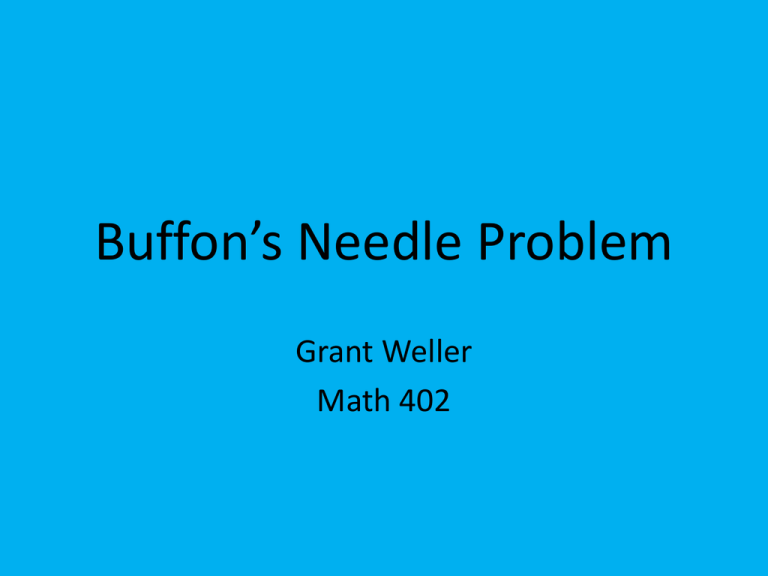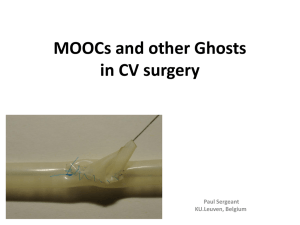Buffon`s Needle Problem
advertisement

Buffon’s Needle Problem Grant Weller Math 402 Georges-Louis Leclerc, Comte de Buffon • French naturalist, mathematician, biologist, cosmologist, and author • 1707-1788 • Wrote a 44 volume encyclopedia describing the natural world • One of the first to argue for the concept of evolution • Influenced Charles Darwin Georges-Louis Leclerc, Comte de Buffon • Introduced differential and integral calculus into probability theory • His “needle problem” is one of the most famous in the field of probability • Introduced these concepts in his paper Sur le jeu de franc-carreau Buffon’s Needle Problem • Suppose that you drop a needle on ruled paper. • What is the probability that the needle comes to lie in a position where it crosses one of the lines? Buffon’s Needle Problem • Answer: it depends on the length of the needle! • For simplicity, assume that the length of the needle l is less than the distance d between the lines on the paper • Then the probability is equal to (2/π)(l / d) • This means that you can use this experiment to get an approximation of π! Finding π • If you have a needle of shorter length than the distance between the lines, you can approximate π with this experiment. • If you drop a needle P times and it comes to cross a line N times, you should eventually get π ≈ (2lN)/(dP). • This experiment is one of the most famous in probability theory! Lazzarini’s Experiment • In 1901 he allegedly built a machine to do this experiment • He used a stick with (l / d)=5/6 • Dropped the stick 3408 times • Found that it came to cross a line 1808 times • Approximated π ≈ 2(5/6)(3408/1808) = (355/113) = 3.1415929… • Correct to six digits of π, too good to be true! Lazzarini’s Experiment • Lazzarini knew that 355/113 was a great approximation of π • He chose 5/6 for the length ratio because he knew he would be able to get 355/113 that way • If this experiment is “successful,” we hope for P = 113N/213 successes • So Lazzarini just did 213 trials at a time until he got a value that satisfied this ratio exactly! Theorems • If a short needle, that is, one with l≤d, is dropped on paper that is ruled with equally spaced lines of distance, then the probability that the needle comes to lie in a position where it crosses one of the lines is exactly p=(2/π)(l/d). • If l>d, this probability is p=1+(2/π)((l/d)(1-√(1-d2/l2))-arcsin(d/l)) Proof • Can be solved by integrals • First, E. Barbier’s proof (1860): • Consider a needle of length l≤d, and let E(l) be the expected number of crossings produced by dropping the needle. • Let l = x+y (break the length of the needle into two pieces • Then we can get E(x+y) = E(x)+E(y) (linearity of expectation) Proof ctd. • Furthermore, we can show that E(cx) = cE(x) for all cєR, because for x≥0, as the length x of the needle increases, the expected number of crossings increases proportionately. • We also know that c=E(1), the probability of getting one crossing from the needle. • Consider needles that aren’t straight. For example a polygonal needle Proof ctd. • The number of crossings produced by this needle is the sum of the number of crossings produced by its straight pieces. • If the total length of the needle is l, we again have E = cl (again by linearity of expectation) • In other words, it is not important whether the needle is straight or even if the pieces are joined together rigidly or flexibly! Proof ctd. • Now consider a needle that is a perfect circle, call it C, with diameter d. • This needle has length dπ • This needle always produces two intersections Proof ctd. • We can now use polygons to approximate the circle. • Let’s draw an inscribed polygon Pn and a circumscribed polygon Pn. Pn Pn Proof ctd. • Remember that for the polygonal needles the expected number of crossings is just cl, or the constant times the length of the needle. • Also, if a line intersects Pn, it will intersect C, and if a line intersects C, it will hit Pn. • Thus E(Pn) ≤ 2 ≤ E(Pn) • And cl(Pn) ≤ 2 ≤ cl(Pn) n Pn P Proof ctd. • Since both the polygons approximate C for n→∞, we know that lim n→∞ l(Pn) = dπ = lim n→∞ l(Pn) • Thus for n→∞, we have cdπ ≤ 2 ≤ cdπ • This gives us c = (2/π)(1/d)!!! • Thus the probability of a needle of length l crossing a line is cl = (2/π)(l/d). A much quicker proof! • We could have done this proof with integral calculus! • Consider the “slope” of the needle. Let it drop at an angle α from the horizontal • α falls in the range 0 to π/2 • The height of this needle is then α lsin α, and the probability that it crosses a line of distance d is (lsin α)/d. A much quicker proof ctd. • Thus the probability of an arbitrary needle crossing a line can be found by averaging this probability over the possible angles α. 1 p /20 /2 0 l sin 2 l 2 l /2 d ( cos )0 d d d What about for a long needle? • For a long needle, as long as it falls in a position where the “height” lsin α is less than the distance between the lines d, the probability is still (lsin α)/d. • This occurs when 0 ≤ α ≤ arcsin (d/l) • If α is larger than this, the needle must cross a line, so the probability is 1 α Long needle probability • Thus for l≥d, we just have a longer integral: p 2 arcsin( d / l ) ( 0 /2 l sin d 1d ) d arcsin( d / l ) l d arcsin( d / l ) ( [ cos ]0 ( arcsin( ))) d 2 l 2 l d2 d 1 ( (1 1 2 ) arcsin( )) d l l 2 • As you would expect, this formula yields 2/π for l=d, and goes to 1 as l→∞ Probability for any needle • If we let the distance between the lines on the paper be 1, this is what the probability function looks like for needles of increasing length: References • “Buffon’s Needle Problem”. Chapter 21, Proofs from the Book. • http://en.wikipedia.org/wiki/GeorgesLouis_Leclerc%2C_Comte_de_Buffon • http://en.wikipedia.org/wiki/Buffon's_needle • http://mathworld.wolfram.com/BuffonsNeedl eProblem.html








